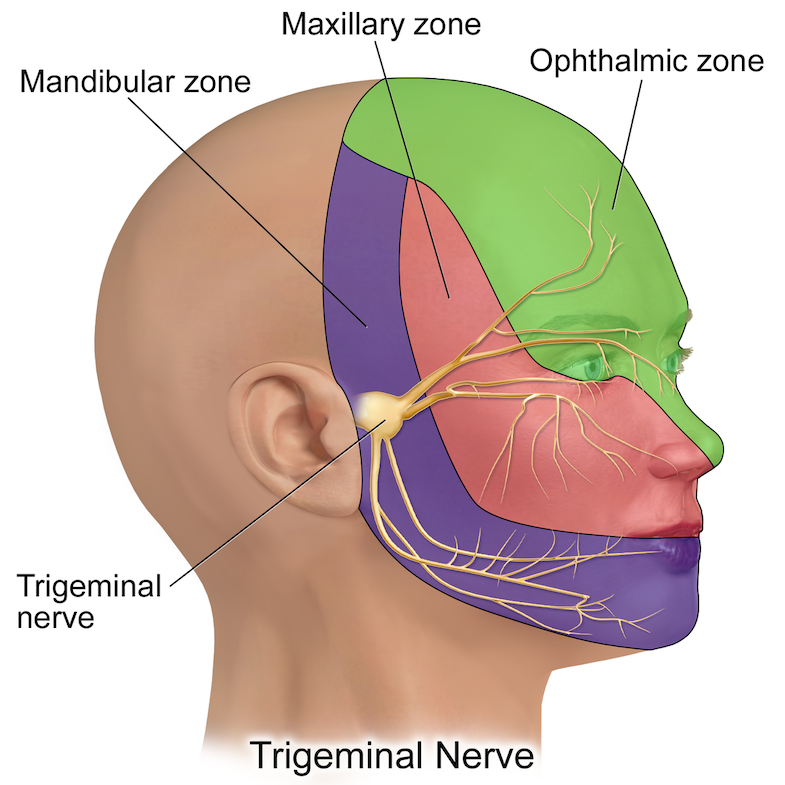Facial Pain
Facial pain is relatively common and, for many people, a normal, acute response to injury or other trauma. For others, this type of pain can become chronic and interfere with their daily life. Why some cases become chronic and not others is not always well understood. Here’s what we do know along with some treatment options.
What is facial pain?
Facial pain is a particular type of pain that can occur in any part of your face. It occurs in many people and can have a variety of causes. The major types of facial pain, or conditions that can lead to it, include:
- Neuropathic pain
- Trigeminal neuralgia
- Headaches and migraines
- Atypical pain
Other conditions include dental problems or temporomandibular joint dysfunction (TMD or TMJ).
Neuropathic facial pain
In general, there are two different nerves that are responsible for the majority of neuropathic facial pain cases: the trigeminal nerve and the sphenopalatine ganglion.
The trigeminal nerve enervates many parts of your face. It has three branches, affecting three different areas of the face (e.g., lips, inside the mouth, forehead, and cheeks). One or more of these branches can lead to pain.
Trigeminal neuralgia is an irritation or inflammation of the trigeminal nerve. This form of pain is very challenging, as it can be triggered by simple, everyday activities. For some people, even smiling or brushing their teeth can lead to a pain flare-up.
Another bundle of nerves responsible for some conditions is the sphenopalatine ganglion. The sphenopalatine ganglion sits directly behind your nose. It’s most often connected to facial pain that occurs in the front part of your face.
Neuropathic pain may also originate from the occipital nerves in a condition called occipital neuralgia. This type of pain originates from the back of the head and radiates to the face.
Identifying the correct nerve that’s causing your pain is vital to establishing a treatment plan.

Atypical facial pain
Atypical facial pain is usually idiopathic, meaning that there is no known cause.
It generally occurs in one side of the face, and symptoms are present for most of the day, every day. The diagnosis of atypical facial pain is made after more common causes are excluded.
How to treat facial pain
The most successful pain treatments typically rely on a comprehensive approach. Your doctor may include one of more of the following seven treatments in your overall pain management plan.
1. Over-the-counter medications
Non-steroidal anti-inflammatory medications can be helpful in treating pain. Use as directed by your doctor for best results.
2. Comfort measures
Hot or cold therapy can be remarkably effective in treating any kind of pain and inflammation, and facial pain is no different.
3. Prescription medications
Some medications used for neuropathic pain include anticonvulsants (gabapentin, carbamazepine) and antidepressants (Cymbalta, Savella, amitriptylline).
Migraine pain is usually treated by utilizing one or more migraine medications, typically one that aims to prevent an onset of symptoms and another that reduces the duration of a migraine should one occur.
Note that opioid therapy is generally no longer recommended for chronic pain conditions (including facial pain).
4. Splints
Splints are used most frequently to treat pain caused by temporomandibular joint disorder (commonly referred to as either TMD or TMJ). These position the jaw to relieve pain and ease soreness.
5. Nerve blocks
Nerve blocks can both diagnose the cause of your nerve pain and also help relieve pain in some patients. These may include:
- Trigeminal nerve blocks
- Occipital nerve blocks
- Sphenopalatine ganglion blocks
6. Injections
Steroid injections directly into the joint may help with TMD pain. Trigeminal neuralgia patients may also find relief with a steroid injection that includes calcitonin.
Botox injections may also help some patients with severe migraines.
7. Neuromodulation
Severe neuropathic facial pain is also commonly treated by neuromodulation, such as a spinal cord stimulator or a peripheral nerve stimulator. A 2019 review of literature found promising results for neuromodulation in the relief of intractable pain.
References
- Chan-Liao, Mingi. Sphenopalatine Ganglion Block- A Simple But Underutilized Therapy for Pain Control. Retrieved February 15, 2010 from: http://www.pain-manage.org.tw/s-pain/s-pain05.htm
- Krolczyk, Stanley (2010) Persistent Idiopathic Facial Pain: Differential Diagnoses & Workup. Retrieved February 15, 2010 from: http://emedicine.medscape.com/article/1142187-diagnosis
- Slavin, K., Colpan, E. , Munawar, N., et al (2006). Trigeminal and Occipital Peripheral Nerve Stimulation for Craniofacial Pain. Retrieved February 16, 2010 from: http://www.medscape.com/viewarticle/554865